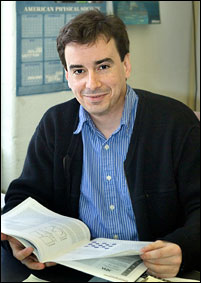Spintronic Materials Show Their First Move
Physicists trace the "hopping" of single electrons in magnetic materials
March 21, 2005
LOS ANGELES, CA - How much energy does it take for an electron to hop from atom to atom, and how do the magnetic properties of the material influence the rate or ease of hopping? Answers to those questions could help explain why some materials, like those used in a computer hard drive, become conductors only in a magnetic field while they are very strong insulators otherwise. They might also help scientists learn how to use the electron's "spin" (a property analogous to the spinning of a child's toy top), as well as its charge, to carry information in a new field known as spintronics.
Stéphane Grenier, a postdoctoral fellow studying electronic excitations, or "electron hopping," at the U.S. Department of Energy's Brookhaven National Laboratory, will describe the techniques he uses and the properties of these materials at the March 2005 meeting of the American Physical Society in Los Angeles, California. His talk will take place on Monday, March 21, at 2:30 p.m. in room 151 of the Los Angeles Convention Center.
"We are looking at something very local, electrons hopping between a pair of atoms, to help us understand important macroscopic effects," Grenier says. "This information could help predict which materials might have the properties needed for particular applications - say, increasing the storage capacity of computer hard drives - and direct the fabrication of new materials in which these properties are optimized."
To determine the energy needed by an electron to hop from one atom to another atom, Grenier used a technique called inelastic x-ray scattering at the Advanced Photon Source at Argonne National Laboratory. He shines x-ray light onto the sample and measures the tiny difference in energy between the incoming and outgoing photons. This difference is the amount of energy needed to move the electrons.
He used this technique to study materials with different magnetic "lattices" - ferromagnetic and antiferromagnetic. In ferromagnetic materials, the atoms' magnetic moments (that is, their spins) are all aligned in the same direction. In antiferromagnetic materials, the magnetic moments of the adjacent atoms point in opposite directions. "When the magnetic moments are aligned, the electron hopping is increased between particular atoms. That is, more electrons make the jump to their neighbors, and it takes less energy to move them," Grenier says. "While this has been known for a while, we have shown the direction in which the electrons move and exactly what price they 'pay,' in terms of energy, to move, and the influence the magnetic lattice of the material has on this hopping."
The electrons want to align their own magnetic moments, or spins, with that of the atoms in the lattice, he explains. "They will do so only if all the atoms' magnetic moments are aligned - that is when the 'fare' for hopping has its lowest price," he said.
Electrons moving with their spins aligned in the same direction make a current of spins, which could be used, somewhat like currents of electrical charge are now used, to pass or transform information in future electronic components made of tailored magnetic lattices - a future generation of circuits based on the science of "spintronics," which is also carried out at Brookhaven Lab. Grenier's studies, along with theoretical analysis of the materials, may also help scientists understand why some materials possess properties such as superconductivity and "colossal magnetoresistance," the ability of some strong insulators to become good conductors when induced by a magnetic field.
Studies on atomic magnetism have applications for understanding novel materials - including spintronic materials and superconductors - that will revolutionize the electronic and energy industries. Such studies using x-rays can only be performed in the U.S. at x-ray synchrotron radiation facilities built and managed by the U.S. Department of Energy's Office of Science.
This research was funded by the Office of Basic Energy Sciences within the U.S. Department of Energy's Office of Science.
Note to local editors: Stéphane Grenier lives in Coram, New York.
2005-10287 | INT/EXT | Newsroom










